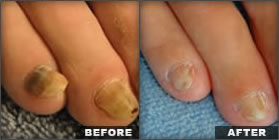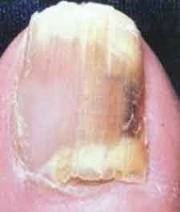Posts Tagged ‘treatment regimen’
How Can I Permanently Cure My Toenail Fungus?
How Can I Permanently Cure My Toenail Fungus?
 Doctors tend to shy away from the word “cure” when referring to toenail fungus because it is not an easy thing to do. We have become a very busy society that believes popping a pill will take care of everything. Unfortunately that is not the case with toenail fungus. Onychomycosis, the medical term for toenail fungus is hard to cure because the treatment regimen is very long and can be quite involved. Most kinds of fungus are able to lie dormant for a long period so people will go through treatment and get positive results, only to find that the infection returns. Curing toenail fungus permanently is a possibility, it just take work and patience.
Doctors tend to shy away from the word “cure” when referring to toenail fungus because it is not an easy thing to do. We have become a very busy society that believes popping a pill will take care of everything. Unfortunately that is not the case with toenail fungus. Onychomycosis, the medical term for toenail fungus is hard to cure because the treatment regimen is very long and can be quite involved. Most kinds of fungus are able to lie dormant for a long period so people will go through treatment and get positive results, only to find that the infection returns. Curing toenail fungus permanently is a possibility, it just take work and patience.
Several factors must be taken into account when examining your chances of curing toenail fungus. First is how far along your toenail fungal infection is. If you can catch it early, you stand a better chance of eliminating it entirely. As a fungal infection progresses, it goes from the skin surrounding the toenail into and under the toenail, where it becomes much harder to eradicate. Second is your own level of commitment. Treating toenail fungus is much more involved than just taking a pill. The idea is to create a hostile environment for the fungus so that they die off. This may involve washing your feet several times a day with a special soap and then donning clean socks each time. Yes, this is a lot of work (and extra laundry) but if you wish to control and end the toenail fungal infection, you will need to follow all of your doctor’s instructions as well as educate yourself on how to avoid recurrence.
The most unfortunate part about curing toenail fungus is that the statistics are so out of whack on actual success because so many people get frustrated part way through their cure and give up, or they miss a day or two and get pushed back by two weeks. This negates the outcome of the studies that have been done, or at least makes the conclusion “unknown”. If you are going to treat your toenail fungus, you need to address all of the problems and be willing to put in the time and effort it will take to achieve a successful result.
Oral prescription medication
If you and your doctor decide that the oral prescription medication is the way to go, ask about helping the process along by using a natural topical antifungal like Tea Tree Oil as part of your healing regimen. Giving your body help from both the inside and the outside can work in your favor. The goal behind combining your efforts is to permanently eradicate the fungi living off of you. This combination of efforts will take effort on your part in maintaining a healthy for you/not healthy for the fungus environment.
The biggest barrier to a cure for toenail fungus for most people is the amount of time and work that go into treatment of this disease. Washing your feet and applying medication 2-3 times a day as well as doing extra laundry to make sure your socks are clean and finding shoes that allow your feet to breath will become stressful. You must remember that missing one day of treatment will undo the last four you worked so hard on as it only takes the fungus one day to re-establish themselves. If you can stick to the program, with the help of your doctor, you can permanently end your toenail fungus problem.
Some Useful Information When Looking for Nail Fungus Treatments
Some Useful Information When Looking
for Nail Fungus Treatments
 Nail fungus, known medically as Onychomycosis, is not an easy condition to treat. Primarily cosmetic in nature, it most commonly affects the toenails.
Nail fungus, known medically as Onychomycosis, is not an easy condition to treat. Primarily cosmetic in nature, it most commonly affects the toenails.
People who are at risk for contracting nail fungus are:
- Older people,
- Males,
- People with diabetes
- People who have had trauma to their nails
- People with hyperhydrosis
- People who suffer from peripheral vascular disease
- People who have athlete’s foot
- People with an immunodeficiency
- People who practice poor hygine
- People who spend a lot of time in the water
There are a number of different species of fungus that can infect the nail. It is also common to find several different fungal infections at one time. The visible symptoms of nail fungus are a thick, discolored and distorted looking nail.
Curing nail fungus has historically been problematic. Modern medicine has found several new options for curing nail fungus. Visiting your health care provider to determine what kind of infection you have and confirming that it is in fact a nail fungus, instead of some other nail infection, is paramount to a successful treatment regimen. Discovery of this is fairly simple. Your doctor can take scrapings and/or clippings of the infected nail to examine under a microscope, and if necessary, send to a lab for culture.
Once you know what you are dealing with, your nail fungus treatment can begin. A common treatment option is an oral prescription antifungal medication. Two older, and therefore proven and well documented, medications are griseofulvin and fluconazole. Unfortunately these medications aren’t effective on all forms of nail fungus and for the fluconazole, the treatment can last up to 9 months.
Two new comparatively to the market prescription medications that have proven effective against nail fungus are terbinafine and itaconazole. These have both proven to be more effective than their older cousins, fluconazole and griseofulvin.
Terbinafine is taken daily over the course of three months. It is reported to be well tolerated with no negative drug interactions with other medications or significant side effects.
Itaconazole runs in a weekly cycle of three weeks on and three weeks off over the course of 3-5 months. People who take a protease inhibitor should not take itaconazole.
For those who do not wish to take an oral prescription, there are alternatives.
A topical medication is now available for curing nail fungus. Your doctor can prescribe using a nail polish containing 8% ciclopirox solution. You paint this on your nail, as you would a regular nail polish, and the adjacent skin every day for 12 months. This treatment is not as effective as oral prescription medication and the course of treatment is lengthy.
As you consider how to treat your onychomycosis, please keep in mind that no matter what medication you choose and however long the treatment cycle is, the nail has to grow out completely clear before the fungus is considered gone. It can take some people more than a year to replace a disfigured toenail.
There are some folks who opt for surgery. This is a more drastic treatment for nail fungus and should be considered a later option as it can be both painful and possibly disfiguring. If other options are unavailable to you because other medications are either ineffective or inappropriate, this can be a good solution to your nail fungus problem.
Alternative medicine treatments are another possible solution. Tea Tree Oil has been shown in some studies to cure nail fungus. The Mayo Clinic has one published report if you are interested in reading up on this treatment.
There are many home remedies that have been suggested by individuals who have had success with them. Most of these are not considered to be viable treatments by the medical community, but that does not mean they cannot prove effective. Home remedies include:
- A 20-30 minute foot soak in vinegar, lemon juice, Listerine, or a solution of bleach
- Nutritional supplements such as acidophilus
- Applying baking soda, garlic, olive oil or Vick’s VapoRub to the infected nail
Modern medicine has created many successful options when it comes to curing nail fungus. Consulting your health care provider and doing some research yourself are two positive steps in the right direction. Armed with the correct information, you and your health care provider can create an effective plan to solve your nail fungus problem.